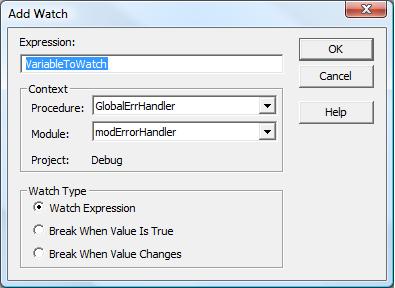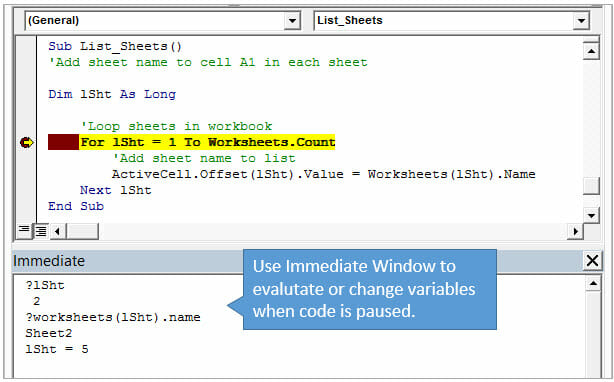Debugging Techniques for Excel 2016 VBA
※ Download: Excel vba debug.print
So, am I correct? If you want to execute the called procedure without stepping through it, press SHIFT F8. Print Join V, delim Next myRow End Sub Then PrintRange rng would work as expected.

But if you just want to test the macro that contains arguments, you can use the Immediate Window to call it. The same functionality just like in Your section , but in different context. The example below is a macro that loops through all the sheets in the workbook and checks to see if each sheet is empty not used.

Debugging Techniques for Excel 2016 VBA - Related Training: Get full access to the. Richard - May 25, 2018 Hi Jon, I have been writing a 2D interpolation macro and have been struggling with a particular bit nothing to do with the maths.

By You may run into some problems with your VBA code, but how do you find the problem? Sometimes your VBA code may need some debugging. This method, of course, requires knowledge and experience. At times like that, you are lucky if you can even see your code, let alone find the bugs. Using the MsgBox function A common problem in many programs involves one or more variables not taking on the values you expect. In such cases, monitoring the variable s while your code runs is a helpful debugging technique. One way to do this is by inserting temporary MsgBox functions into your routine. The following statement displays the current value of two variables: LoopIndex 1 and CellCount 72 , separated by a space. Otherwise, the message box strings the two values together, making them look like a single value. You can also use the built-in constant, vbNewLine, in place of the space character. The following statement displays three variables, each on a separate line: Using a message box to display the value of three variables. You can use a message box to display all sorts of useful information while your code is running. For example, if your code loops through a series of sheets, the following statement displays the name and type of the active sheet: MsgBox ActiveSheet. The code continues executing. The VBE goes into Debug mode. A help screen tells you that you pressed Ctrl+Break. Pressing Ctrl+Break halts execution of your code and gives you some choices. Feel free to use MsgBox functions frequently when you debug your code. Just make sure that you remove them after you identify and correct the problem. Print statements As an alternative to using MsgBox functions in your code, you can insert one or more temporary Debug. Use these statements to print the value of one or more variables in the Immediate window. Print LoopIndex, CellCount, MyVal Notice that the variables are separated with commas. You can display as many variables as you like with a single Debug. Print sends output to the Immediate window even if that window is hidden. Print statement sends output to the Immediate window. Print statements do not halt your code. Even big companies like Microsoft occasionally forget to remove their Debug. That problem was finally fixed in Excel 2007. Using the VBA debugger The Excel designers are intimately familiar with the concept of bugs. Consequently, Excel includes a set of debugging tools that can help you correct problems in your VBA code.
You can use the Row or Column property of any of those methods to return the row and column numbers. Single step through the rest of the code to see how Excel VBA enters the other numbers. However I've just started learning excel vba debug.print and and can't quite understand. The vast majority of the time you will not need to use Resume. Print statement sends output to the Immediate window. I need to get the partial or full text of codes from the line of Error is occurring. You can deal with these errors using Unit Testing and Assertions. How you implement logging really depends on the nature of the application and how useful it will be. I chose a space:.



